Oral Health
4 min read
Aug 21, 2025
Teeth Whitening Statistics & Trends
Teeth whitening has grown from a luxury procedure to a mainstream cosmetic treatment accessible to people worldwide. Consumers today are investing in their smiles as much as they invest in skincare, haircare, and personal style. Whether it’s for a job interview, a wedding, or just personal confidence, teeth whitening has become a regular part of aesthetic self-care.
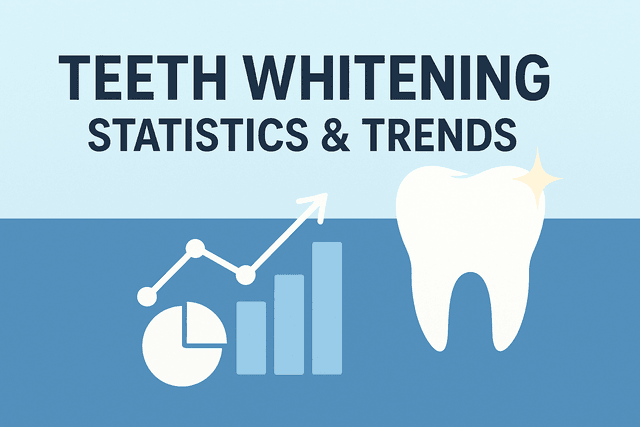
Who Whitens Their Teeth? Prevalence Statistics
Teeth whitening is the most requested cosmetic dental treatment in the United States. According to the American Dental Association (ADA), cosmetic whitening is surging in popularity, with demand higher than ever (ADA News).
A YouGov survey found that 19% of Americans have undergone professional whitening, with usage peaking among adults under 45. In this group, 26% reported whitening their teeth, compared to just 14% of those over 45 (YouGov Survey).
An additional report by Alpine White found that 32% of adults aged 35–54 have whitened their teeth using either professional treatments or home methods, whereas only 20% of adults over 55 have done so (Alpine White Demographics).
This trend shows that younger generations are significantly more invested in cosmetic dental care, likely due to the influence of social media, selfies, and dating apps where appearance is under constant scrutiny.
Teeth Whitening Usage by Age (U.S.)
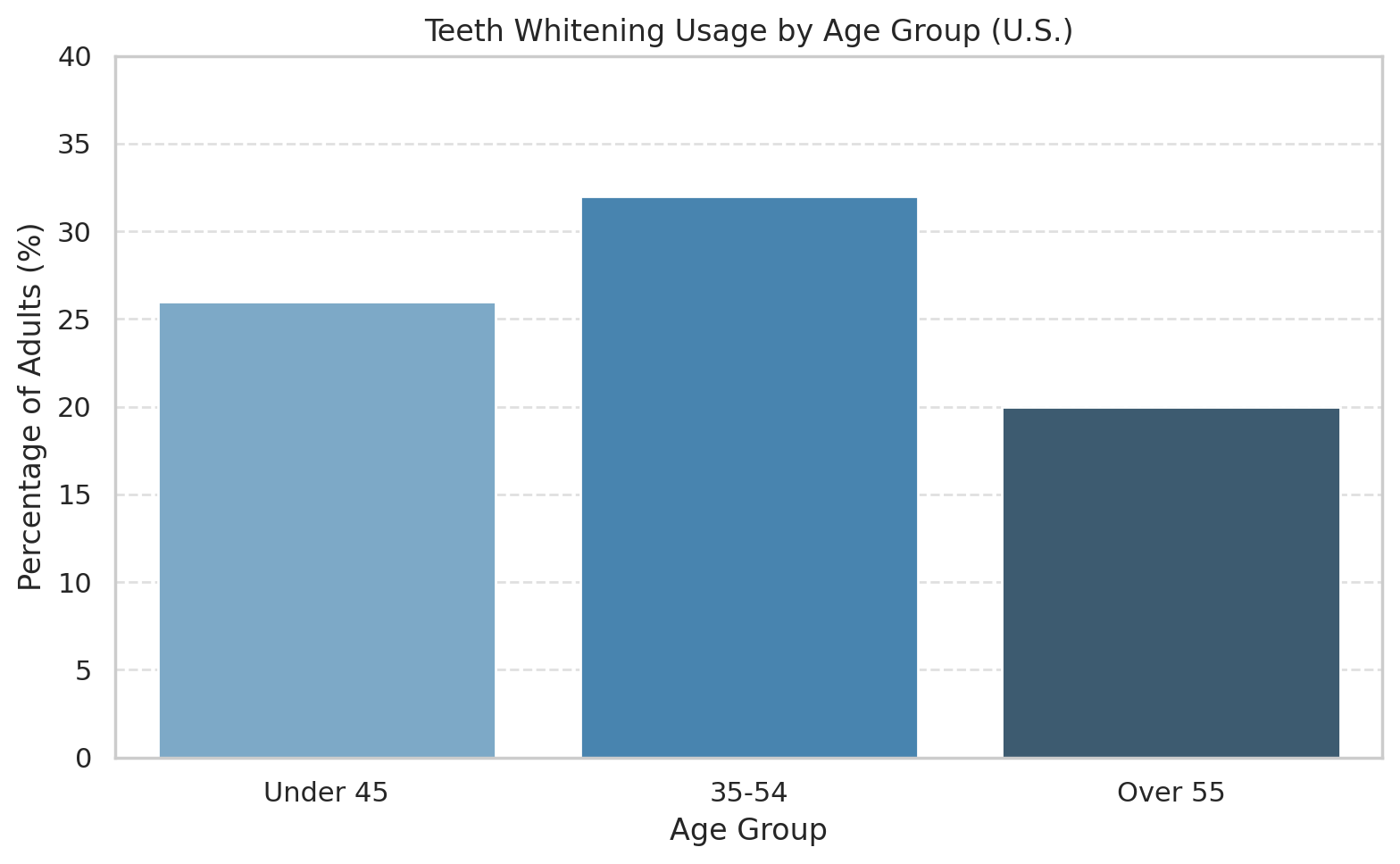
In-Office vs. At-Home Whitening Trends
Consumers today have multiple options for teeth whitening. Both in-office treatments and at-home solutions are popular, but they differ in price, effectiveness, and convenience.
In-Office Whitening
In-office whitening is done by dentists using high-concentration peroxide solutions. This method can lighten teeth by 5–8 shades in a single 60-minute session, offering instant gratification. Dentists also manage sensitivity during treatment, making it safer for those prone to enamel issues. According to Sola Dental Spa, professional in-office whitening typically costs $500–650 on average but can go up to $1,000 depending on the clinic (Sola Dental Spa).
At-Home Whitening (Dentist Supervised)
Many dentists provide take-home kits with custom-made trays and lower-concentration bleaching gels. This method allows users to whiten gradually over 2–4 weeks, often at a cost of $375–500, according to CareCredit (CareCredit Whitening Cost Guide).
Over-the-Counter (OTC) Whitening
Over-the-counter whitening products include strips, gels, pens, and LED kits. These kits typically use lower peroxide concentrations (around 7–12%) compared to professional treatments (up to 35%). While results are more subtle, 1–3 shades lighter over several weeks, they are significantly cheaper, ranging from $5 to $100 (Byrdie LED Whitening Kits Guide).
Effectiveness Comparison
A systematic review on PMC found no significant difference in shade improvement between in-office and at-home dentist-supervised treatments, though in-office whitening works faster. Sensitivity was found to be a common side effect for both (PMC Systematic Review).
Cost and Treatment Comparison
Treatment Type | Average Cost (USD) | Shade Improvement | Time to Results |
In-Office Whitening | $575 | 5–8 shades | 1 hour |
Take-Home Dentist Kit | $438 | Gradual (2–4 weeks) | Weeks |
OTC/LED Home Kits | $70 | 1–3 shades | Several weeks |
Laser Whitening | $792 | Up to 8 shades | 1–2 sessions |
Global Teeth Whitening Market Growth
The teeth whitening industry is not just growing; it’s exploding.
According to The Dental Spa Jersey, the market was worth $6.14 billion in 2020, and is projected to reach $8.21 billion by 2026 (Dental Spa Jersey).
Grand View Research reports a 5% compound annual growth rate (CAGR), predicting the market will reach $10.7 billion by 2030 (Grand View Research Report).
Data Bridge Market Research projects an even higher growth rate of 5.5% CAGR, bringing the market to $12.4 billion by 2032 (Data Bridge Report).
Fortune Business Insights aligns with these findings, forecasting the industry will grow to $12.77 billion by 2032 (Fortune Business Insights).
Overall growth is driven by factors such as:
Increasing aesthetic awareness
Rising disposable incomes
The expansion of OTC whitening products into emerging markets
Psychological and Social Impact of Teeth Whitening
Whiter teeth don’t just make people look better; they make them feel better too. Research confirms the psychological benefits of teeth whitening:
Confidence & Self-Perception
A study published on PMC used the Psychosocial Impact of Dental Aesthetics Questionnaire (PIDAQ) to measure the effects of whitening. Participants reported improved dental confidence and reduced feelings of inferiority after treatment (PIDAQ Study on PMC).
Social and Professional Perception
According to All Smiles Bethesda, patients often report that whitening makes them feel more approachable, trustable, and comfortable in social settings (All Smiles Bethesda).
A Gen-Z-focused study on ScienceDirect found whitening positively affected social media presence, dating success, and job interview confidence (ScienceDirect Gen-Z Study).
Additional Observations
Media reports from Teen Vogue and Self have cited that whiter teeth are linked to perceptions of higher intelligence, better hygiene, and even increased hireability in job interviews.
Who Typically Gets Their Teeth Whitened?
Teeth whitening is most common among adults under 45, with nearly 26% having undergone treatments, compared to about 14% of those over 45. Surveys also show that 32% of adults aged 35–54 have whitened their teeth, while only 20% of those over 55 have done so. Younger generations, influenced by social media, selfies, and dating culture, are driving this trend, making whitening a key part of personal grooming and confidence-building.
What Are the Differences Between In-Office and At-Home Whitening?
In-office whitening, performed by dentists, delivers rapid results of 5–8 shades lighter in just one hour but is also the most expensive, averaging $575. Dentist-supervised take-home kits provide gradual whitening over 2–4 weeks for around $438. Over-the-counter products are the most affordable, averaging $70, but offer more subtle results of 1–3 shades lighter. Effectiveness studies show little difference in final outcomes between professional and supervised at-home treatments, though in-office sessions work faster.
How Fast Is the Global Teeth Whitening Market Growing?
The global teeth whitening industry was valued at $6.14 billion in 2020 and is projected to surpass $12 billion by 2032, depending on the source. Growth rates range between 5%–5.5% CAGR, fueled by rising disposable incomes, increasing demand for aesthetic treatments, and the widespread availability of over-the-counter whitening products in emerging markets. This steady expansion reflects how whitening has shifted from a luxury to an everyday cosmetic routine.
What Are the Psychological and Social Benefits of Teeth Whitening?
Research shows that whiter teeth can significantly boost self-confidence and social perception. Patients report feeling more attractive, approachable, and even more hireable in professional settings. Studies highlight improvements in self-esteem, reduced social anxiety, and enhanced dating and job interview confidence. Media outlets also connect brighter smiles with perceptions of higher intelligence, better hygiene, and stronger overall appeal.
Read Next
Related Posts
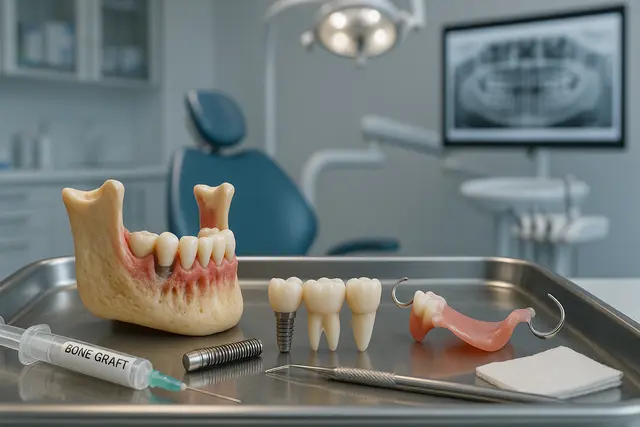
Oral Health
Tooth Replacement Options to Prevent Bone Loss
Losing a tooth isn’t just about appearance, it can have a lasting impact on your oral health, jawbone strength, and overall quality of life. When teeth go missing, the jawbone begins to shrink, which can change your bite, your facial structure, and even your confidence. Fortunately, modern dentistry offers several effective solutions to replace missing teeth and prevent further bone loss.
4 min read
Sep 26, 2025
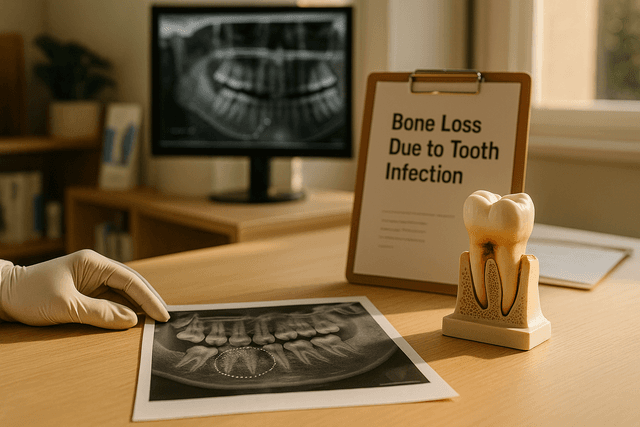
Oral Health
Bone Loss Due to Tooth Infection Explained: What It Means for Your Oral Health
A tooth infection isn’t just about pain, it can quietly damage the tissues around a tooth and even erode the jawbone that supports your smile. This guide explains how infections start, why they can lead to bone loss, the warning signs to watch for, and the treatments that can stop the spread and rebuild lost support.
5 min read
Sep 25, 2025
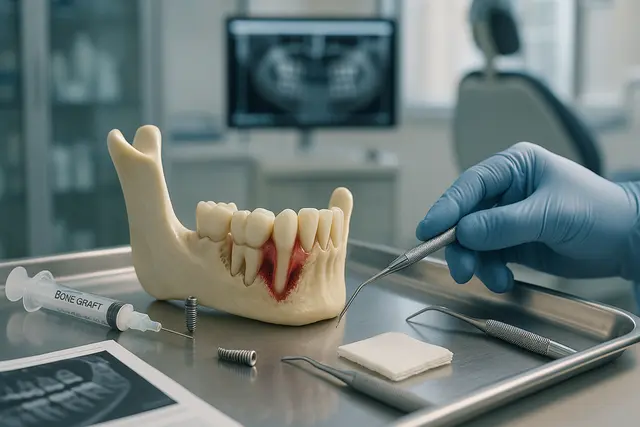
Oral Health
Understanding Bone Loss in Teeth: Causes and Treatments That Work
Bone loss in teeth is a silent threat that can compromise your smile, facial structure, and overall oral health. While it often goes unnoticed in the early stages, it can lead to serious consequences if left untreated. Understanding what causes dental bone loss, and how to prevent or manage it, is key to maintaining a strong, healthy foundation for your teeth.
5 min read
Sep 25, 2025
Don’t have time to research every dentist around you?
See why 30k+ patients trusted us